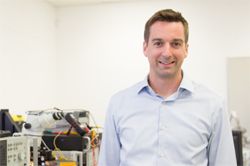Aug 22 2014
Robert Candler, assistant professor of electrical engineering at the UCLA Henry Samueli School of Engineering and Applied Science, has received a $1 million research grant from the W. M. Keck Foundation to develop an ultra-compact X-ray free electron laser.
 Robert Candler. Credit: UCLA
Robert Candler. Credit: UCLA
Such a device could be used for ultra-high-speed and high-resolution imaging in chemistry, biology, materials science and condensed matter physics. For example, in the life sciences, one could view images with resolutions clear enough to see individual carbon atoms, or to discern events such as a chemical reactions that last one quadrillionth of a second or shorter.
Currently, there is only one X-ray laser device in the U.S. capable of producing this level of high-speed and high-resolution imaging. It’s at the Stanford Linear Accelerator (SLAC) national laboratory and is therefore available to a limited number of researchers.
UCLA’s two-year project aims to produce a miniaturized free electron laser that could fit in a typical college laboratory. The laser produces powerful X-rays by extracting energy from bunches of electrons that are traveling nearly the speed of light. The researchers will develop this device with by using novel nanofabrication techniques combined with cutting-edge free electron laser physics.
Partnering in this effort with Candler, who also is a member of the California NanoSystems Institute, are Pietro Musumeci, UCLA associate professor of physics and astronomy, and James Rosenzweig, UCLA professor and chair of physics and astronomy.
The success of this study will lead to the creation of ultra-compact X-ray free electron lasers (XFELS). Ultimately, the group envisions developing XFELS that are three- to four-meters long, much smaller than the kilometer-scale facilities used today. The devices will be capable of producing high-brightness X-rays that generate ultrafast, high-resolution images in the X-ray water window – wavelengths between 2.33 and 4.37 nanometers, at which carbon in biological specimens absorbs incoming X-rays while water remains relatively transparent. These miniature XFELS will create a paradigm shift by making this tool for transformational science widely available to scientists in several fields.
The W. M. Keck Foundation funds distinct and novel research programs with promising and transformative impact that will advance technology and sciences for the preservation of life, access to innovative solutions and a better understanding of the world we live in.